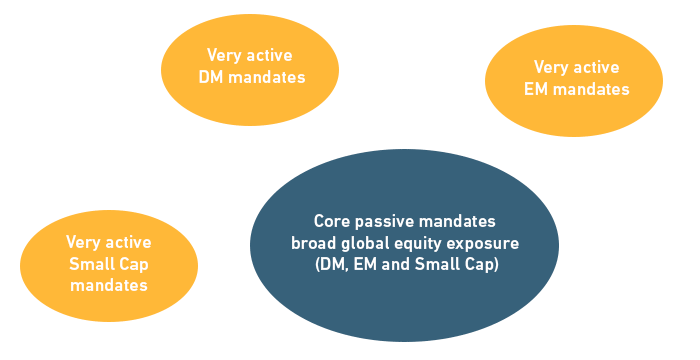
Investors have long debated the benefits of active versus passive investing. There are institutional investors with strong convictions in each camp, but many have become increasingly pragmatic, combining active and passive mandates in pursuit of the best risk-adjusted return. We examined the active management opportunity in different equity market segments and, in particular, the potential role of very active mandates across segments through the use of a core-satellite portfolio structure.
Proponents of both active and passive management agree on a few basic principles. It is notoriously difficult for managers to deliver alpha repeatedly on a risk-adjusted basis, and while exceptionally skillful active managers exist, skills and resources are needed to identify them consistently. Thus, the active/passive decision often reflects cost considerations and resource constraints.
In addition, institutional investors often rely on the relative efficiency of individual equity market segments to gauge their active management potential. For instance, the small-cap segment and emerging markets are perceived as less efficient than the large-cap segment and developed markets. Thus, active management is generally thought to be more promising for small-cap and emerging markets mandates.
That view is supported by data from the MSCI indexes on return dispersion, which was higher among small-cap stocks than large caps and higher among emerging market equities than developed ones for the 10-year period ending March 31, 2010. This data indicates that there is a higher potential for active managers to add value in the small-cap segment and emerging markets.
For institutional investors, the return dispersion among managers may be a more relevant measure of active management potential. We found that manager performance dispersion is often higher in U.S. small caps than in U.S. large/mid caps. That phenomenon is consistent with the higher return dispersion in the small-cap segment itself.
On the other hand, over the 10 years ending March 2010, emerging market managers demonstrated lower return dispersion than global managers operating in developed markets — the opposite of what might be expected. That might be because some EM managers index their holdings, thus reducing their dispersion rates, or because some developed mandates allow for limited EM exposure, thus inflating theirs.
Given such results, institutional investors may consider active and passive management as complementary, rather than alternative, strategies across these different equity segments.
For a global equity allocation that spans developed and emerging markets and includes small caps, one possible core-satellite structure would combine passive and very active mandates in each of these equity market segments. Core passive mandates offer broad global equity exposure, and the very active mandates reflect the investor’s conviction in active management and skills in selecting active managers.
>Illustration of a Potential Implementation Option using Core-Satellite Structure

One potential benefit of such a structure is that it gives institutional investors more flexibility in managing beta exposure and the alpha component across equity market segments. For instance, changes to asset allocation can be made through the passive mandates without undermining the alpha decisions made by the satellite managers. The structure enables both passive and active managers to focus on their core competencies. More importantly, it allows institutional investors to employ high active risk mandates, even when aggregate risk must be kept to modest levels.
Read the paper, “Some Like It Hot.”
